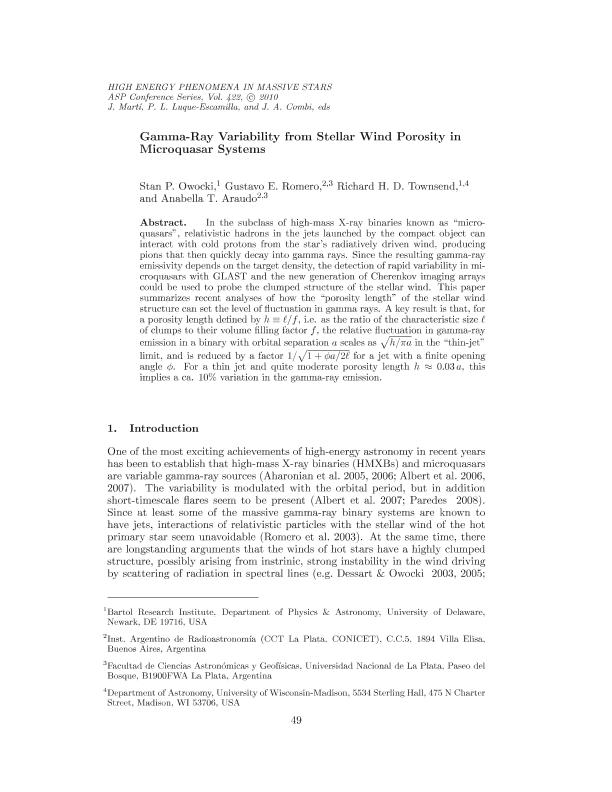Mostrar el registro sencillo del ítem
dc.contributor.author
Owocki, Stanley P.
dc.contributor.author
Romero, Gustavo Esteban

dc.contributor.author
Townsend, Richard H. D.
dc.contributor.author
Araudo, Anabella Teresa

dc.date.available
2016-07-01T20:44:49Z
dc.date.issued
2010-06
dc.identifier.citation
Owocki, Stanley P.; Romero, Gustavo Esteban; Townsend, Richard H. D.; Araudo, Anabella Teresa; Gamma-ray variability from stellar wind porosity in microquasar systems; Astronomical Society of The Pacific; Astronomical Society of The Pacific Conference Series; 422; 6-2010; 49-54
dc.identifier.issn
0004-6280
dc.identifier.uri
http://hdl.handle.net/11336/6309
dc.description.abstract
In the subclass of high-mass X-ray binaries known as “microquasars,” relativistic hadrons in the jets launched by the compact object can interact with cold protons from the star's radiatively driven wind, producing pions that then quickly decay into gamma rays. Since the resulting gamma-ray emissivity depends on the target density, the detection of rapid variability in microquasars with GLAST and the new generation of Cherenkov imaging arrays could be used to probe the clumped structure of the stellar wind. This paper summarizes recent analyses of how the “porosity length” of the stellar wind structure can set the level of fluctuation in gamma rays. A key result is that, for a porosity length defined by h ≡ L/f, i.e. as the ratio of the characteristic size L of clumps to their volume filling factor f, the relative fluctuation in gamma-ray emission in a binary with orbital separation a scales as (h/πa)1/2 in the “thin-jet” limit, and is reduced by a factor ( 1 + φ a/2L )-1/2 for a jet with a finite opening angle φ. For a thin jet and quite moderate porosity length h ≍ 0.03a, this implies a ca. 10% variation in the gamma-ray emission.
dc.format
application/pdf
dc.language.iso
eng
dc.publisher
Astronomical Society of The Pacific
dc.rights
info:eu-repo/semantics/openAccess
dc.rights.uri
https://creativecommons.org/licenses/by-nc-sa/2.5/ar/
dc.subject
Microquasars
dc.subject
X-Ray Binaries
dc.subject
High Energy Astrophysics
dc.subject.classification
Astronomía

dc.subject.classification
Ciencias Físicas

dc.subject.classification
CIENCIAS NATURALES Y EXACTAS

dc.title
Gamma-ray variability from stellar wind porosity in microquasar systems
dc.type
info:eu-repo/semantics/article
dc.type
info:ar-repo/semantics/artículo
dc.type
info:eu-repo/semantics/publishedVersion
dc.date.updated
2016-06-15T19:20:19Z
dc.journal.volume
422
dc.journal.pagination
49-54
dc.journal.pais
Estados Unidos

dc.description.fil
Fil: Owocki, Stanley P.. University of Delaware. Bartol Research Institute, Department of Physics & Astronomy; Estados Unidos
dc.description.fil
Fil: Romero, Gustavo Esteban. Consejo Nacional de Investigaciones Científicas y Técnicas. Centro Científico Tecnológico La Plata. Instituto Argentino de Radioastronomia (i); Argentina. Universidad Nacional de la Plata. Facultad de Ciencias Astronómicas y Geofísicas; Argentina
dc.description.fil
Fil: Townsend, Richard H. D.. University of Delaware. Bartol Research Institute, Department of Physics & Astronomy; Estados Unidos. University Of Wisconsin; Estados Unidos
dc.description.fil
Fil: Araudo, Anabella Teresa. Consejo Nacional de Investigaciones Científicas y Técnicas. Centro Científico Tecnológico La Plata. Instituto Argentino de Radioastronomia (i); Argentina. Universidad Nacional de la Plata. Facultad de Ciencias Astronómicas y Geofísicas; Argentina
dc.journal.title
Astronomical Society of The Pacific Conference Series
dc.relation.alternativeid
info:eu-repo/semantics/altIdentifier/url/http://aspbooks.org/custom/publications/paper/422-0049.html
Archivos asociados
